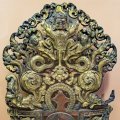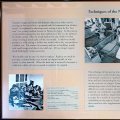Patan Museum (Nepal): photo 207
Photo 207 of 212 in Gallery: Patan Museum (Nepal)

Image title: Metalsmith Reference Manual
Description of the photo
This photograph depicts an ancient Metalsmith’s Reference Manual [Nepal, 18th century Handmade paper, black ink]—Both sides of the fifteen folios of this small accordion-folded manuscript (thyasaphu) are filled with rough sketches and notes respecting various aspects of the metallurgical arts. Most of the sketches relate to the making of sheet metal images of the Buddha whose various parts are shown accompanied by detailed measurements. The exhibited folios describe the style preferred in Patan while the reverse folios give the Kathmandu preference. Thus, for example, the height of a Patan Buddha’s cranial bump is to be four fingers high and 24 fingers around while that of a Kathmandu Buddha is to be six fingers high and only 18 fingers around. There is also a reminder that when affixing the head to the torso it should be slightly tipped down.
Scattered throughout the manual are also various instructions respecting gilding and soldering and several recipes are recorded. For example, gilt may be made by mixing one part by weight of gold to three parts by weight of mercury or, as jotted elsewhere, by melting one ratti (an archaic measure) of fine copper, one of silver, and six of gold (but no mention of the essential mercury). Gold, it is written, can be purified by adding one part by weight of salt and five parts by weight of powdered brick to the melted gold. There are also various recipes for soldering compounds.
This manual seems to be an apprentice’s notes since after one of the recipes he comments “as told by [my] twice venerable guru [teacher].” In making his own manual, the apprentice recycled another for barely visible under his work are very fine decorative scroll drawings and other motifs. One is an engaging mouse overdrawn by the lines of the Kathmandu Buddha's left cheek.
The exterior folio of the manual has remains of blood, chicken feathers, and vermilion applied to the manual during the annual worship of Vishwakarma [Vishvakarma], the heavenly architect and patron saint of artists and artisans. The text is written in old Newari language and Newari script. Both attest to limited literacy which together with the use of many archaic terms makes the text difficult to decipher.
Gallery information:
The Patan Museum is located on the Durbar square of Patan (Lalitpur/Lalitapura, Kathmandu, Nepal) which is associated Keshav Narayan Chowk (Keshavnarayan)—a form of Lord Vishnu. Being listed as a World Heritage Site, the whole of Durbar square is filled with exquisite temples, sculptures and other ancient structures, of which the ancient history history can be traced to the Malla Kings of Lalitpur. It is an important site for both Buddhism and Hinduism.
Photo details:
Date: 2019-12-02
Camera: SONY ILCE-6400
Exposure: 1/30
Aperture: f/4.5
ISO: 100
Focal length: 18mm
High resolution:
Download file
Size: 4.73 MB
Resolution: 1584 x 5004
© Photograph by Gabe Hiemstra.
License: CC BY-NC-ND 4.0

